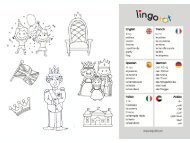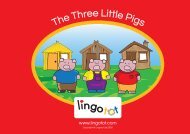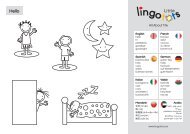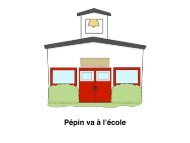Lingotot Guide to Early Language Learning
- No tags were found...
Create successful ePaper yourself
Turn your PDF publications into a flip-book with our unique Google optimized e-Paper software.
<strong>Lingo<strong>to</strong>t</strong> <strong>Guide</strong> <strong>to</strong> <strong>Early</strong> <strong>Language</strong> <strong>Learning</strong><br />
<strong>Lingo<strong>to</strong>t</strong> <strong>Guide</strong> <strong>to</strong><br />
<strong>Early</strong> <strong>Language</strong> <strong>Learning</strong><br />
1
<strong>Lingo<strong>to</strong>t</strong> <strong>Guide</strong> <strong>to</strong> <strong>Early</strong> <strong>Language</strong> <strong>Learning</strong><br />
<strong>Lingo<strong>to</strong>t</strong> <strong>Guide</strong> <strong>to</strong> <strong>Early</strong> <strong>Language</strong> <strong>Learning</strong><br />
Contents<br />
Chapter 1: The benefits of early language learning<br />
2<br />
2 Chapter 2: When is the best time <strong>to</strong> start?<br />
3<br />
Angela Sterling is an experienced MFL teacher,<br />
mother of two daughters and founder of <strong>Lingo<strong>to</strong>t</strong> Ltd.<br />
Since its launch in January 2010 the company has gone from strength <strong>to</strong> strength with its aim of introducing babies,<br />
<strong>to</strong>ddlers and young children <strong>to</strong> a new language through s<strong>to</strong>ries, songs, games and play. Classes are interactive and<br />
fun, designed <strong>to</strong> introduce adults and children <strong>to</strong> a new language in a friendly and relaxed environment. Classes are<br />
available in community centres, schools and nurseries across the UK.<br />
A note from Angela:<br />
“My name is Angela and I founded <strong>Lingo<strong>to</strong>t</strong> in 2010 when on<br />
maternity leave with my first child. It was the thought of<br />
impending motherhood which finally gave me the push <strong>to</strong><br />
start <strong>Lingo<strong>to</strong>t</strong> classes in my local area.<br />
It had been a lifelong ambition of mine <strong>to</strong> start teaching<br />
languages <strong>to</strong> very young children. I went <strong>to</strong> Paris <strong>to</strong> work<br />
as an Au Pair when I was 18 and I looked after children as<br />
young as two who spoke multiple languages fluently. I was<br />
always very impressed at how easily they switched from<br />
one language <strong>to</strong> another.<br />
After graduating from university, I enjoyed a teaching<br />
career working in a range of schools with a range of ages<br />
both in the UK and overseas.<br />
Despite my fluency in French and my teaching background, I<br />
was still nervous at the prospect of speaking French <strong>to</strong> my<br />
new baby. Although I am fluent in French, I am not a native<br />
speaker and I worried about not being the “perfect” model<br />
for my baby girl. So instead of reading the usual pregnancy<br />
books, I surrounded myself with research papers and books<br />
on bilingual education!<br />
What I learned was that, not only was I perfectly capable<br />
of introducing a second language <strong>to</strong> my children, but that<br />
I could also help others do the same thing – even if they<br />
couldn’t speak that language at all. And that’s what<br />
<strong>Lingo<strong>to</strong>t</strong> is all about. <strong>Early</strong> foreign language experiences for<br />
children and advice for parents and teachers who would like<br />
<strong>to</strong> help (and perhaps learn a little themselves!)”<br />
Angela<br />
Chapter 3: Which language should I choose?<br />
Chapter 4: How do I support my child at home?<br />
Interaction<br />
Routine<br />
Play time<br />
Songs<br />
Books<br />
TV & DVDs<br />
Technology<br />
Chapter 5: Community support<br />
Chapter 6: Myth Buster<br />
Chapter 7: Get started!<br />
4<br />
5<br />
6<br />
7<br />
8<br />
9<br />
10<br />
11<br />
12<br />
13<br />
15<br />
16<br />
2<br />
1
<strong>Lingo<strong>to</strong>t</strong> <strong>Guide</strong> <strong>to</strong> <strong>Early</strong> <strong>Language</strong> <strong>Learning</strong><br />
<strong>Lingo<strong>to</strong>t</strong> <strong>Guide</strong> <strong>to</strong> <strong>Early</strong> <strong>Language</strong> <strong>Learning</strong><br />
The benefits of early<br />
language learning 1<br />
When is the best<br />
time <strong>to</strong> start? 2<br />
But why should we be bothering with other languages anyway?<br />
Everyone speaks English, right?<br />
There are so many benefits <strong>to</strong> knowing a second<br />
language. The most obvious ones spring <strong>to</strong> mind first;<br />
travelling, understanding other cultures, enjoying films,<br />
books, music from different countries, intercultural<br />
understanding etc. <strong>Learning</strong> additional languages<br />
enables learners <strong>to</strong> engage with people of diverse<br />
cultures in ways that recognise differences and create<br />
cultural understanding. <strong>Language</strong> is inseparable from<br />
ways of knowing the world and involves connecting,<br />
engaging, and interacting with others and negotiating<br />
boundaries.<br />
There are many advantages which are less obvious.<br />
Knowing two languages can give you allround<br />
intellectual benefits. Being multilingual improves school<br />
performance and increases overall problem-solving<br />
skills. Research also suggests bilingual children are<br />
more creative than monolingual speakers and score<br />
higher on academic tests. It’s also been suggested<br />
that bilingual <strong>to</strong>ddlers have better concentration <strong>to</strong>o.<br />
According <strong>to</strong><br />
Dr. James Mason, Columbia University of Development,<br />
“Research also proves that young children who<br />
learn a language before the age of five tend<br />
<strong>to</strong> have superior reading, writing, analytical<br />
and social skills, as well as more extensive<br />
vocabularies than their monolingual peers.”<br />
Being multilingual is a plus on both college admission<br />
applications and job applications as well. Top<br />
universities really rate A levels in foreign languages,<br />
which appear on university “A lists” of subjects. For<br />
example, at Trinity College, Cambridge a whopping 11<br />
of the 25 subjects on their A list are languages. After<br />
your studies you could well earn more money <strong>to</strong>o if<br />
you are bilingual. To find and keep valuable bilingual<br />
workers, employers are willing <strong>to</strong> pay larger sums of<br />
money. On average, bilingual pay differentials range<br />
between 5 and 20 percent per hour more than the<br />
position’s base rate, according <strong>to</strong> research. Being<br />
bilingual can actually help your health <strong>to</strong>o! Research<br />
shows that the regular use of two languages appears <strong>to</strong><br />
delay the onset of Alzheimer’s disease symp<strong>to</strong>ms.<br />
With all of these benefits<br />
available, the question shouldn’t<br />
be “why should I learn a second<br />
language?”, rather it should be<br />
“can I afford not <strong>to</strong> learn another<br />
language?”<br />
“Being bilingual, it turns out,<br />
makes you smarter.”<br />
YUDHIJIT BHATTACHARJEE, NY Times<br />
I get asked this question a lot. Because I run foreign<br />
language sessions for babies, <strong>to</strong>ddlers and young<br />
children, some parents approach me concerned that<br />
they’ve “left it <strong>to</strong>o late” <strong>to</strong> start. The great news is that<br />
it’s never <strong>to</strong>o early or <strong>to</strong>o late <strong>to</strong> start learning another<br />
language! There are distinct advantages <strong>to</strong> starting <strong>to</strong><br />
learn at different ages.<br />
Adult learners are very motivated. Perhaps you regret<br />
not learning a language when we were younger,<br />
perhaps you need <strong>to</strong> use it for work, but whatever the<br />
reason you can bet you don’t have a lot of spare time<br />
so your dedication will be second-<strong>to</strong>-none! There’s no<br />
slacking off for adults, they hammer the books hard!<br />
At the start of secondary school, learners go through<br />
what I like <strong>to</strong> call a brain growth spurt! This is an ideal<br />
time <strong>to</strong> learn lots of new things, including a language.<br />
Perhaps this is one of the reasons why languages<br />
were traditionally introduced at aged eleven in the UK. At<br />
this age, children already know how <strong>to</strong> learn which gives<br />
them an amazing head start over younger children.<br />
Primary school children have lots of enthusiasm for<br />
language learning. They love <strong>to</strong> show off what they have<br />
learned and they are curious about other cultures. As<br />
they are beginning <strong>to</strong> read and write, they have a range<br />
of sources they can access for help in their language<br />
learning. They can begin <strong>to</strong> read in the foreign language<br />
and try some writing <strong>to</strong>o. All of these skills make for a<br />
great start and they often make better progress than<br />
babies and <strong>to</strong>ddlers in the beginning.<br />
Having said all of that, I personally believe the best time<br />
<strong>to</strong> start introducing a second language is when they are<br />
babies or <strong>to</strong>ddlers. Very young children will pick up the<br />
language in the same way as they learned<br />
their mother <strong>to</strong>ngue, naturally and easily. Think of it this<br />
way: When a baby is born, it has no idea where in the<br />
world it is going <strong>to</strong> arrive. Its brain is lovely and flexible,<br />
ready <strong>to</strong> soak up any new language it hears. At about<br />
the age of 8-10 months, the baby then starts <strong>to</strong> “tune in”<br />
<strong>to</strong> the language(s) it hears around him/her. This means<br />
that foreign language sounds which do not exist in the<br />
mother <strong>to</strong>ngue, start <strong>to</strong> be “tuned out” ever so gradually.<br />
You can read more about this here and here.<br />
Many experts do agree that there seems <strong>to</strong> be an<br />
‘optimal’ time period for learning a second language:<br />
from birth <strong>to</strong> three years. In other words, right when a<br />
child is learning the first language. The time when his/<br />
her mind is still open and flexible. <strong>Learning</strong> a second<br />
language boosts <strong>to</strong>ddlers’ brain function.<br />
It has even been suggested that babies born <strong>to</strong> bilingual<br />
mothers who regularly spoke both languages during<br />
pregnancy exhibit different language preferences than<br />
infants born <strong>to</strong> mothers speaking only one language.<br />
I often hear people say that children are like “sponges”<br />
who “soak up” language effortlessly. If this is the case,<br />
then why not take advantage of this incredible skill <strong>to</strong><br />
introduce new languages <strong>to</strong> them? Just imagine, you<br />
could save them from hours and hours conjugating<br />
verbs in a classroom, sweating over pages of vocabulary<br />
learning and an accent that’s never quite right. Instead<br />
you could nurture not only their language skills, but their<br />
love of that language <strong>to</strong>o!<br />
You may want <strong>to</strong> watch this fascinating video - one of my<br />
favourites - Patricia Kuhl: The linguistic genius of babies<br />
“Young minds soak up foreign<br />
languages like a sponge”<br />
EMILY WEITZ<br />
2<br />
3
<strong>Lingo<strong>to</strong>t</strong> <strong>Guide</strong> <strong>to</strong> <strong>Early</strong> <strong>Language</strong> <strong>Learning</strong><br />
<strong>Lingo<strong>to</strong>t</strong> <strong>Guide</strong> <strong>to</strong> <strong>Early</strong> <strong>Language</strong> <strong>Learning</strong><br />
Which language<br />
should I choose? 3<br />
How do I support my<br />
child at home? 4<br />
For some people choosing a language is easy and obvious. Perhaps you are a native or fluent speaker of a<br />
language or you have relatives who are. However, if you are like many families here in the UK, perhaps your<br />
experience is limited <strong>to</strong> some basic school-level French and asking for two beers on holiday in Spanish! That makes<br />
your decision a little tricky.<br />
By that I don’t mean <strong>to</strong> be flippant. I’m simply trying <strong>to</strong> convey the message that language selection is not<br />
necessarily straightforward. Even if you have a strong link <strong>to</strong> a particular language in your family, you may prefer <strong>to</strong><br />
introduce a different language al<strong>to</strong>gether depending on your goals and aspirations for your child(ren). Many families<br />
base the decision on which languages are the most widely spoken. Others may have more business-like aspirations<br />
and choose a language such as German or Mandarin Chinese as these are perceived <strong>to</strong> be more useful and<br />
widespread in the business world. Whatever your reasons for your choice, it is essential that you surround yourself<br />
with the right kind of support. You can successfully bring a language <strong>to</strong> life for your children even if you don’t speak it,<br />
but it will take careful planning and a dedicated approach.<br />
You may want <strong>to</strong> consider the following as<br />
a good starting point on language choice:<br />
Frequent questions that may concern you and<br />
things people will ask you<br />
• Do you have a strong preference for or a love of<br />
a particular language?<br />
• Have you studied any languages or do you know<br />
them well?<br />
• Do you feel comfortable using this language with<br />
your child(ren)?<br />
• Are there any other family members with<br />
language skills?<br />
• How often would you or other members of your<br />
family be able <strong>to</strong> use the language with your little<br />
one(s)?<br />
• Are there any languages spoken in your local<br />
area which you could easily access?<br />
• What kind of languages classes or playgroups<br />
are available locally?<br />
• Do any local nurseries or childminders offer a<br />
second language?<br />
• Do you live close <strong>to</strong> a university or similar<br />
institution where you could easily access<br />
foreign-speaking babysitters?<br />
This chapter is all about giving practical advice on how<br />
<strong>to</strong> achieve your goal. All of my professional and personal<br />
experiences in the field of language learning has taught<br />
me that the best and easiest way for a child <strong>to</strong> learn a<br />
language, whether it is their first or second language, is<br />
<strong>to</strong> surround them with the sounds of that language as<br />
much as possible. This means that they are surrounded<br />
by that language regularly.<br />
So what can you do if you want <strong>to</strong> raise a bilingual child,<br />
but only speak one language yourself? It can be difficult<br />
<strong>to</strong> find the opportunities, however it is also easier for<br />
them <strong>to</strong> learn a second language at this age, so the<br />
extra effort will be worth it.<br />
Don’t forget that when you have chosen your<br />
language that dedication is they key - so stick with it!<br />
4<br />
5
<strong>Lingo<strong>to</strong>t</strong> <strong>Guide</strong> <strong>to</strong> <strong>Early</strong> <strong>Language</strong> <strong>Learning</strong><br />
<strong>Lingo<strong>to</strong>t</strong> <strong>Guide</strong> <strong>to</strong> <strong>Early</strong> <strong>Language</strong> <strong>Learning</strong><br />
Interaction<br />
Routine<br />
In my opinion, language learning begins at home just in<br />
the same way all learning does. Our children learn an<br />
awful lot before setting foot in an educational institution,<br />
including how <strong>to</strong> speak.<br />
Consider how children learn their native language. They<br />
learn <strong>to</strong> talk through constant chatter with adults while<br />
conducting everyday tasks. They hear language all the<br />
time; while eating breakfast <strong>to</strong>gether, playing games,<br />
singing songs strapped in<strong>to</strong> their carseat, being talked <strong>to</strong><br />
during a nappy change, splashing at bathtime. After<br />
hearing language constantly over man many hours they<br />
start <strong>to</strong> experiment themselves and suddenly it bursts<br />
from them. So whatever you do <strong>to</strong> introduce a new<br />
language, you need <strong>to</strong> do an awful lot of it.<br />
This is exactly how you should begin <strong>to</strong> tackle learning<br />
a second language. I always say <strong>to</strong> people <strong>to</strong> forget the<br />
notion of “French Fridays” or “Spanish Saturdays”.<br />
Not only does it put immense pressure on you, but it’s not<br />
the most effective way <strong>to</strong> learn. Simply use the language<br />
in bursts as you go about your daily routine. Sing songs,<br />
point and name objects in the foreign language, chatter,<br />
chatter, chatter!<br />
At <strong>Lingo<strong>to</strong>t</strong> sessions, we give you lots of ideas on how <strong>to</strong><br />
do this and even give you handouts with suggestions at<br />
every class.<br />
Help! I can’t speak the language myself! You don’t<br />
need <strong>to</strong> be fluent <strong>to</strong> give your child the gift of a second<br />
language and this guide is full of ideas if you lack<br />
language skills. However I would strongly recommend<br />
you learn alongside your child. That’s why it’s so<br />
important you come <strong>to</strong> <strong>Lingo<strong>to</strong>t</strong> sessions <strong>to</strong>gether. You<br />
learn the language at the same time.<br />
You already do something naturally which makes this<br />
process seem less scary. As children grow and begin<br />
<strong>to</strong> interact with us through speech we au<strong>to</strong>matically<br />
begin <strong>to</strong> use longer sentences and more complex<br />
language. This means you have time <strong>to</strong> get <strong>to</strong> that stage.<br />
Simple words and phrases are a great way <strong>to</strong> start and<br />
your language skills will develop as your child needs<br />
something more complicated.<br />
However, don’t worry! We have lots of ways for you<br />
<strong>to</strong> access more sophisticated language even if your<br />
language skills remain basic.<br />
Things <strong>to</strong> try at home:<br />
• Start as early as possible and talk in the<br />
foreign language as much as possible!<br />
• Encourage all of your family and friends <strong>to</strong><br />
use the language around your little one. This<br />
includes grandparents, siblings, babysitters<br />
and all visi<strong>to</strong>rs <strong>to</strong> your home.<br />
• Create a sense of importance <strong>to</strong> the<br />
language. Use it with great enthusiasm and<br />
make it fun.<br />
• Use special props which will interest your<br />
child and consider having a special <strong>to</strong>ybox<br />
full of items you use when speaking the<br />
language.<br />
• Sing little songs and dance about the room<br />
singing them!<br />
• Read s<strong>to</strong>ries in the foreign language every<br />
day.<br />
How your every day routine compliments language<br />
learning.<br />
You should try <strong>to</strong> incorporate the second language in<strong>to</strong><br />
your daily routine as much as possible as young children<br />
need <strong>to</strong> hear a lot of language before they being <strong>to</strong><br />
reproduce it themselves. You will all get the maximum<br />
amount of benefit if the language is used in meaningful<br />
and interactive situations.<br />
Even if you have the most basic language skills you can<br />
sing a silly song in the target language, repeat a few<br />
words of vocabulary or perform counting tasks. You will<br />
also pick up all of these skills and many more at <strong>Lingo<strong>to</strong>t</strong><br />
sessions.<br />
Here are some practical tips<br />
you could do every single day:<br />
• If you know the names of everyday items<br />
around your home, you can point <strong>to</strong> them<br />
and repeat the word in the foreign language.<br />
• If you can’t remember them very well make<br />
labels and signs with your children in the<br />
target language and place these around<br />
your environment, indoors and outside. This<br />
has the added bonus of involving your child in<br />
the learning process.<br />
• Sing and sing some more. Even if you only<br />
learn one or two songs (we all know how<br />
much children love repetition!). You will learn<br />
lots of new songs at <strong>Lingo<strong>to</strong>t</strong> or you could<br />
purchase a copy of our CD LingoTunes<br />
(purchase from your class tu<strong>to</strong>r or on iTunes)<br />
• Count everything! Fingers, <strong>to</strong>es, eyes and<br />
nose! Count the stairs as you carry your little<br />
on up <strong>to</strong> bed. Count the birds you see in the<br />
sky, count blocks as you build a <strong>to</strong>wer....I think<br />
you get the drift!<br />
• Do the same thing with colours. As well as<br />
counting the blocks, say what colour they are<br />
<strong>to</strong>o.<br />
• Use the foreign language <strong>to</strong> greet and say<br />
goodbye <strong>to</strong> visi<strong>to</strong>rs. This has the added<br />
benefit of your child seeing others use the<br />
language <strong>to</strong>o and therefore they will see it<br />
being of value <strong>to</strong> the whole family. Plus which<br />
granny could resist seeing their beloved<br />
grandchild respond <strong>to</strong> “au revoir” with a<br />
goodbye wave?<br />
• Create a ‘language corner’ with posters,<br />
books and maybe even some bilingual <strong>to</strong>ys<br />
where you only speak the foreign language.<br />
• Play with puppets. Older children can be<br />
encouraged <strong>to</strong> make the puppets speak in<br />
the chosen language.<br />
6<br />
7
<strong>Lingo<strong>to</strong>t</strong> <strong>Guide</strong> <strong>to</strong> <strong>Early</strong> <strong>Language</strong> <strong>Learning</strong><br />
<strong>Lingo<strong>to</strong>t</strong> <strong>Guide</strong> <strong>to</strong> <strong>Early</strong> <strong>Language</strong> <strong>Learning</strong><br />
Play Time<br />
Songs<br />
Those of us who work with young children know how invaluable singing is for early literacy skills<br />
and this is also true of language learning. Babies and young children love songs and rhymes,<br />
especially hearing the sound of your voice. And they’re a great way <strong>to</strong> help your child’s talking and<br />
listening skills in a foreign language.<br />
According <strong>to</strong> Sally Goddard Blythe, a consultant in neuro-developmental education and direc<strong>to</strong>r of the Institute for<br />
Neuro- Physiological Psychology, “Lullabies, songs and rhymes of every culture carry the ‘signature’ melodies and<br />
inflections of a mother <strong>to</strong>ngue, preparing a child’s ear, voice and brain for language.”<br />
Here are some ways in which singing can help<br />
with language learning:<br />
Playing with your child can be a very effective way of<br />
introducing a second language. Afterall our little ones<br />
learn an awful lot through play and in fact, this is how<br />
early years educational settings in the UK prefer <strong>to</strong><br />
“teach” our children nowadays.<br />
You can also buy many bilingual <strong>to</strong>ys for your children<br />
which claim <strong>to</strong> “teach” colours, numbers etc. We do love<br />
these <strong>to</strong>ys at <strong>Lingo<strong>to</strong>t</strong> and we make them available <strong>to</strong><br />
youngsters in our classes, however they must be used<br />
with caution. Children simply do not learn a language<br />
if they sit and play with a <strong>to</strong>y that “speaks” the foreign<br />
language. It quite simply doesn’t work.<br />
Lise Eliot is a well-known neurologist, mother and baby<br />
expert and she says,<br />
“Babies, infants and children learn best from<br />
interaction with other humans. It’s wired in<strong>to</strong> us. In<br />
order <strong>to</strong> learn, children need language situations<br />
where the conversations are interactive,<br />
adaptive, and pitched at their level. If the<br />
conversations are immediately focused on what<br />
they are interested in, that can only help.”<br />
So if we play with the <strong>to</strong>ys with our little ones in an<br />
interactive way, chatting as we go, then progress will<br />
happen - hurrah!<br />
Tips for using language<br />
through play:<br />
• Play simple games in the foreign language<br />
such as peek-a-boo. This is so simple that<br />
anyone can learn the vocabulary <strong>to</strong> join in,<br />
yet it is fun, interactive and meaningful <strong>to</strong> real<br />
life.<br />
• When playing hide and seek, count <strong>to</strong> 10 in<br />
your target language.<br />
• Play with bilingual <strong>to</strong>ys, but remember <strong>to</strong> play<br />
with your child and chat as you go.<br />
• Role-play is a great way <strong>to</strong> use a foreign<br />
language. Have pretend picnics, tea parties,<br />
dress up, play shops, doc<strong>to</strong>rs and nurses<br />
- anything where you can use the foreign<br />
language even just a little bit.<br />
• Building blocks are a great <strong>to</strong>ol for practising<br />
colours and numbers.<br />
• Build up positive associations with the language<br />
by singing, dancing <strong>to</strong> songs and generally<br />
having fun!<br />
• Your voice is your baby’s favourite music so sing<br />
<strong>to</strong> her, even if you don’t think you’re a brilliant<br />
singer, or if you think your French accent isn’t up<br />
<strong>to</strong> scratch. Your baby won’t judge you.<br />
• Turn off the TV or radio so your child can hear<br />
your voice.<br />
• Don’t worry if you don’t know any foreign<br />
language songs. Sing bits of the songs you have<br />
picked up in class or use a CD <strong>to</strong> help. There are<br />
many good resources online or you could pick up<br />
a copy of LingoTunes (see shop below).<br />
• Look at your baby as you sing or chant and see<br />
how he reacts <strong>to</strong> different parts of the rhyme.<br />
• When your baby or <strong>to</strong>ddler joins in, show that<br />
you’ve noticed by giving lots of encouragement.<br />
LingoTunes is the perfect way <strong>to</strong> introduce your child<br />
<strong>to</strong> such songs in French. Here’s what parents are<br />
saying about the songs;<br />
“Loooooving your CD!! lovely singing and<br />
very well sung words so we can hear<br />
them. Too exciting <strong>to</strong> listen <strong>to</strong> and sing<br />
along <strong>to</strong> and the songbook is helpful <strong>to</strong> be<br />
able <strong>to</strong> look at <strong>to</strong>o. Well done”<br />
Hannah, mum <strong>to</strong> Joshua (aged 3)<br />
• Even if your <strong>to</strong>ddler is just beginning <strong>to</strong> talk,<br />
remember that listening is just as important,<br />
especially for learning a foreign language. Listen<br />
<strong>to</strong> his reaction <strong>to</strong> the song or rhyme.<br />
• Choose songs which aren’t <strong>to</strong>o “busy” with lots of<br />
electronic sounds. We want our youngsters <strong>to</strong> be<br />
able <strong>to</strong> really hear the target language.<br />
• Familiar songs translated in<strong>to</strong> another language<br />
provide a very good starting point for children and<br />
adults.<br />
• Try <strong>to</strong> choose songs which have actions. Mixing<br />
sound with kinaesthetic tasks helps the children<br />
<strong>to</strong> pinpoint and learn specific vocabulary.<br />
• With longer, more complicated songs with no<br />
actions, try using some props <strong>to</strong> involve the<br />
children in a task linked <strong>to</strong> the music.<br />
8<br />
9
<strong>Lingo<strong>to</strong>t</strong> <strong>Guide</strong> <strong>to</strong> <strong>Early</strong> <strong>Language</strong> <strong>Learning</strong><br />
<strong>Lingo<strong>to</strong>t</strong> <strong>Guide</strong> <strong>to</strong> <strong>Early</strong> <strong>Language</strong> <strong>Learning</strong><br />
Books<br />
TV and DVDs<br />
<strong>Lingo<strong>to</strong>t</strong> sessions always include a s<strong>to</strong>ry and it’s<br />
amazing just how much the children enjoy it. The room is<br />
usually silent!<br />
Recent research suggests that reading <strong>to</strong> your child is<br />
the single most effective way of increasing the size of<br />
their vocabulary. A study by Janet Patterson found this<br />
<strong>to</strong> be true of second language learning <strong>to</strong>o in her study<br />
of two-year-olds learning English and Spanish. Quite<br />
simply, reading <strong>to</strong> your child in another language is one<br />
of the best ways <strong>to</strong> boost their vocabulary.<br />
Here are our tips on sharing<br />
s<strong>to</strong>ries with your little ones:<br />
• Find a quiet place. Turn off the TV or radio so<br />
there are no distractions.<br />
• As well as reading the s<strong>to</strong>ry, look at the pictures<br />
<strong>to</strong>gether. This is a great way <strong>to</strong> share a book<br />
even if your own language skills are quite basic.<br />
Sharing a simple picture book, pointing and<br />
naming the pictures is a great way for you both<br />
<strong>to</strong> pick up new words.<br />
• Don’t put any pressure on your child <strong>to</strong> name<br />
the pictures, but if they copy your words, praise<br />
them and repeat the words again.<br />
• Don’t read for <strong>to</strong>o long. Young children get<br />
bored quickly so little and often is best.<br />
• Let other grown-ups – grandparents, carers<br />
and older brothers and sisters – join in <strong>to</strong>o.<br />
• It’s good <strong>to</strong> share favourite books again and<br />
again. Repetition helps children <strong>to</strong> understand<br />
and remember the language they hear.<br />
• Remember, you’re not teaching your child <strong>to</strong><br />
read in the foreign language. You learn <strong>to</strong> talk<br />
a long time before you learn <strong>to</strong> read, and book<br />
sharing is a wonderful way <strong>to</strong> help your child’s<br />
language development.<br />
• Even sharing foreign language books with<br />
babies is a good idea. It helps “tune in” their ear<br />
<strong>to</strong> the sounds of the new language.<br />
• You can find foreign language books easily on<br />
the internet on Amazon or specialist suppliers<br />
such as Little Linguist. Don’t forget you can save<br />
10% on your purchases with Little Linguist with<br />
our exclusive discount code. Simply ask at your<br />
<strong>Lingo<strong>to</strong>t</strong> class for the code.<br />
• If you don’t feel confident reading the s<strong>to</strong>ry<br />
yourself, your child will learn a lot from the<br />
expressions and voice on an audio recording<br />
which can be as captivating as the s<strong>to</strong>ry itself.<br />
• Children can learn new vocabulary by joining in<br />
with the repetitive parts of a s<strong>to</strong>ry.<br />
• S<strong>to</strong>ries set in other countries will introduce<br />
children <strong>to</strong> different societies and cultures.<br />
• Substitute words from a different language<br />
when sharing a s<strong>to</strong>ry, for example, the names of<br />
food in ‘The Very Hungry Caterpillar’.<br />
Everyone has heard s<strong>to</strong>ries about someone who<br />
“picked up” a language by watching TV or that Little<br />
Johnny knows loads of Spanish after watching Dora the<br />
Explorer. And it’s true that television can be a useful <strong>to</strong>ol<br />
when learning languages, but I certainly do not agree<br />
that children can simply “pick up” a language by the<br />
power of DVD!<br />
Research shows that very young children can learn<br />
a language even if they are only exposed <strong>to</strong> an hour<br />
every week. However, this must be interactive and not<br />
passively sitting in front of the television. The good<br />
news is that your child doesn’t need you <strong>to</strong> be a<br />
languages teacher or a native speaker. All of the<br />
interactive language activities suggested in this guide<br />
are all much more effective than mindlessly watching<br />
television.<br />
This does not mean that it doesn’t have its place. Watch<br />
the TV <strong>to</strong>gether and talk about it. It can also be useful for<br />
older children who can access the subtitles in a film or<br />
for older children who are becoming quite proficient in<br />
the language.<br />
Television resources for children:<br />
• YouTube is a brilliant resource for television<br />
shows. You can find French versions of<br />
Peppa Pig for example (Peppa Cochon).<br />
• You can access real foreign language<br />
television programmes for children online<br />
instead of translated English shows.<br />
• Amazon and specialist websites such as<br />
Little Linguist have DVDs in many foreign<br />
languages which can be sent <strong>to</strong> you at the<br />
<strong>to</strong>uch of a but<strong>to</strong>n.<br />
• The Lingo Show from CBeebies introduces<br />
languages <strong>to</strong> young children and is available<br />
<strong>to</strong> watch online <strong>to</strong>o.<br />
10<br />
11
<strong>Lingo<strong>to</strong>t</strong> <strong>Guide</strong> <strong>to</strong> <strong>Early</strong> <strong>Language</strong> <strong>Learning</strong><br />
<strong>Lingo<strong>to</strong>t</strong> <strong>Guide</strong> <strong>to</strong> <strong>Early</strong> <strong>Language</strong> <strong>Learning</strong><br />
Technology<br />
Community Support 5<br />
<strong>Early</strong> years language learning works best when you can build a support network around you. Some<br />
children can reject a language as they grow if they don’t perceive it <strong>to</strong> be valuable and see other<br />
people interacting in your chosen language. It is possible that this community support already exists<br />
even if you’re not aware of it!<br />
Family and Friends<br />
If you look around you, you may find many family and<br />
friends who can support you and your child. Here are<br />
some points <strong>to</strong> consider when choosing your language<br />
and looking for support (but don’t worry if it turns out<br />
there is none! There are some more ideas a bit further<br />
on):<br />
• What languages do you already know?<br />
• How confident are you with your own language<br />
skills?<br />
• Do you have any fluent or even native speakers in<br />
your family or social circle?<br />
• How often do you use languages in your everyday<br />
life? Could you increase this?<br />
<strong>Language</strong> Classes and<br />
Playgroups<br />
• This is of course <strong>Lingo<strong>to</strong>t</strong>’s speciality! If you take your<br />
child <strong>to</strong> a music, drama, craft class or playgroup,<br />
<strong>Lingo<strong>to</strong>t</strong> offers all of those things, but in French,<br />
Spanish and Mandarin. This method of learning is<br />
ideal as we teach the language “for real”.<br />
• <strong>Lingo<strong>to</strong>t</strong> classes are also about family learning. You<br />
learn at the same time as your little one and we<br />
teach you how <strong>to</strong> teach your child.<br />
• There are lots of other providers of course and many<br />
of them are fantastic. We would recommend you<br />
avoid sessions which use flashcards, worksheets<br />
and lots of English. Young children learn best<br />
through play.<br />
Making use of technology and the internet can provide<br />
a good starting point for parents who are not <strong>to</strong>o sure<br />
of their own language skills. However, children cannot<br />
simply “pick up” a language in this way.<br />
(please see the section on TV)<br />
Technology resources for children:<br />
• Foreign language TV programmes are<br />
available <strong>to</strong> view or <strong>to</strong> order online.<br />
• Some online resources have a ‘virtual<br />
teacher’. <strong>Lingo<strong>to</strong>t</strong> provides this service <strong>to</strong><br />
schools and nurseries in addition <strong>to</strong> our live<br />
sessions.<br />
• Children love watching themselves on screen<br />
or listening <strong>to</strong> their own voice. Make a video<br />
or audio recording of a singing performance<br />
and share it with your family and friends.<br />
• MP3 players are a very useful <strong>to</strong>ol, and allow<br />
you <strong>to</strong> create a “play list” of tracks which are<br />
specific <strong>to</strong> the target language.<br />
Childcare<br />
• Are there any languages you could access spoken in<br />
the local community?<br />
• Do your local nurseries or childminders offer another<br />
language? This is becoming very popular and<br />
<strong>Lingo<strong>to</strong>t</strong> runs many sessions in nurseries. Please<br />
let us know if you’d like us <strong>to</strong> approach your child’s<br />
nursery.<br />
• Do you live close <strong>to</strong> a university or college? There<br />
may be some international students there who<br />
would love <strong>to</strong> earn a little spare cash babysitting<br />
and you could insist on them speaking the target<br />
language with your child.<br />
• If you have the space, you could consider an au pair.<br />
These are young students who come <strong>to</strong> the UK <strong>to</strong><br />
learn English. In return for bed, board and pocket<br />
money, they provide 25 hours childcare per week.<br />
“People who don’t speak another language<br />
as a native speaker can in fact introduce that<br />
language very successfully <strong>to</strong> our children we just<br />
need <strong>to</strong> look for the resources around us [...] and<br />
that’s why <strong>Lingo<strong>to</strong>t</strong>, which teaches the language<br />
through interaction, through immersion [...] is<br />
absolutely perfect.”<br />
Kendall King, Ph.D., Author of “The Bilingual Edge” &<br />
Associate Professor of Applied Linguistics, George<strong>to</strong>wn<br />
University, BBC Radio 5 Live<br />
• Of course, there are LOTS of Apps out there<br />
which will offer some language support.<br />
12<br />
13
<strong>Lingo<strong>to</strong>t</strong> <strong>Guide</strong> <strong>to</strong> <strong>Early</strong> <strong>Language</strong> <strong>Learning</strong><br />
<strong>Lingo<strong>to</strong>t</strong> <strong>Guide</strong> <strong>to</strong> <strong>Early</strong> <strong>Language</strong> <strong>Learning</strong><br />
Community Support<br />
Myth Buster 6<br />
Frequent questions that may concern you and things people will ask you<br />
School<br />
• Are there any bilingual schools locally?<br />
• Does your child’s school offer another language?<br />
(This is becoming compulsory in English Primary<br />
Schools from age 7 in September 2014)<br />
• How does the school teach foreign languages? Are<br />
they very proactive or is it the first thing that gets<br />
dropped when things get busy?<br />
• Is your child’s language teacher a specialist? Many<br />
primary school teachers have little or no language<br />
experience yet are given the job of teaching it! This<br />
makes for a lot of English and not a lot of the foreign<br />
language spoken in class.<br />
• Does the school offer after school clubs? Perhaps in<br />
a more unusual language?<br />
• <strong>Lingo<strong>to</strong>t</strong> can help with all of the above. We specialise<br />
in teaching in primary schools, both as part of the<br />
curriculum and after school. Please let us know if<br />
you’d like us <strong>to</strong> approach your child’s school<br />
Holidays and Outings<br />
• Of course there’s nothing like experiencing the<br />
language for real on a family holiday.<br />
• Older children can benefit greatly from school visits<br />
and exchanges.<br />
• Not everyone has the budget for this, but you can still<br />
introduce children <strong>to</strong> the culture with smaller local<br />
outings; a visit <strong>to</strong> the cinema <strong>to</strong> watch a foreignlanguage<br />
film; a French breakfast at a local café (or<br />
at home!); a meal at a local speciality restaurant.<br />
• 21st Century Penpals! You can search for penpals<br />
online, write emails, chat on<br />
• Skype. The world really is on your doorstep.<br />
When you make the decision <strong>to</strong> raise your child with a second language there will be lots of questions from those<br />
around you. Some people will be utterly enthusiastic, while others remain more sceptical and will ask you for more<br />
information. You may share some of their concerns deep-down.<br />
Here are some common myths, followed by the actual truth so you can answer their (and your own!) questions with<br />
confidence.<br />
Myth 1<br />
Myth 2<br />
Myth 3<br />
Myth 4<br />
Only native speakers can raise their child with two languages<br />
At <strong>Lingo<strong>to</strong>t</strong> we firmly believe this not <strong>to</strong> be the case. Raising a bilingual child in the UK is <strong>to</strong>ugh for even<br />
bilingual parents. English is “cool”, it enjoys a high status and here in the UK we don’t often hear other<br />
languages being spoken around us. Not all bilingual parents raise bilingual children. Monolingual<br />
parents face the same obstacles and with careful planning, dedication and effort. It can be done.<br />
There are lots of resources <strong>to</strong> help you and I hope we’ve given you lots of ideas in this short eBook.<br />
I’ve left it <strong>to</strong>o late!<br />
It’s never <strong>to</strong>o late <strong>to</strong> learn another language. Yes there are benefits <strong>to</strong> early language learning, but<br />
please refer <strong>to</strong> Chapter 2....it’s never <strong>to</strong>o late.<br />
Bilinguals are late talkers<br />
Children learn <strong>to</strong> speak at different rates, some earlier, some later. It’s very difficult <strong>to</strong> tell. However<br />
there is no scientific evidence <strong>to</strong> show that being exposed <strong>to</strong> two or more languages in the early years<br />
delays speech development. All children develop speech at about the same time.<br />
Bilingual children mix up their languages<br />
Maybe a little, yes, but so do all children! Listen <strong>to</strong> a two-year-old just starting <strong>to</strong> put sentences<br />
<strong>to</strong>gether. They get things mixed up for a little bit while their brain figures out the structure of the<br />
language. This is what a bilingual child is doing <strong>to</strong>o, it just sounds weird <strong>to</strong> us listening in as they<br />
sometimes mix vocabulary and grammar from the two languages <strong>to</strong>gether. They all grow out of it.<br />
It is a passing phase.<br />
Myth 5<br />
Stick them in front of the TV and they’ll pick it up!<br />
NO!! Children need <strong>to</strong> have meaningful interaction in the language <strong>to</strong> learn it properly. They need a<br />
human being. I ask you again <strong>to</strong> watch Patricia Kuhl: The linguistic genius of babies Television does<br />
have its place and can support language learning, but it does not teach.<br />
14<br />
15
<strong>Lingo<strong>to</strong>t</strong> <strong>Guide</strong> <strong>to</strong> <strong>Early</strong> <strong>Language</strong> <strong>Learning</strong><br />
<strong>Lingo<strong>to</strong>t</strong> <strong>Guide</strong> <strong>to</strong> <strong>Early</strong> <strong>Language</strong> <strong>Learning</strong><br />
Get Started! 7<br />
So what are you waiting for? This is an<br />
exciting time for your child and your whole<br />
family. Please remember <strong>to</strong> seek out<br />
support and make an action plan. And<br />
don’t forget that <strong>Lingo<strong>to</strong>t</strong> is here <strong>to</strong> help.<br />
Some points <strong>to</strong> remember...<br />
You need the whole family <strong>to</strong> be fully on board.<br />
What do you do if your partner doesn’t want you<br />
speaking <strong>to</strong> your child in a language he doesn’t<br />
understand? An insecure spouse may fear being<br />
excluded from “the secret language” between the other<br />
parent and the child. Discuss and compromise. It is very<br />
important that couples find an acceptable solution<br />
Have a practical plan.<br />
Agree on who speaks what language <strong>to</strong> whom and then<br />
stick <strong>to</strong> it. Think carefully about your own language skills,<br />
support systems, childcare etc - everything covered<br />
in Chapter 5. Make a timetable if helps <strong>to</strong> keep you on<br />
track.<br />
Build a support network.<br />
This is probably the most underestimated success<br />
fac<strong>to</strong>r, so find others who are raising their children <strong>to</strong><br />
speak your language. Your local <strong>Lingo<strong>to</strong>t</strong> class is perfect<br />
for this. You’ll benefit from their knowledge and be able<br />
<strong>to</strong> share both your doubts and your triumphs. Books,<br />
music, movies, and <strong>to</strong>ys in your minority language are<br />
the most obvious ways <strong>to</strong> boost your child’s exposure.<br />
Re-read Chapter 4!<br />
Be patient.<br />
Raising bilingual children requires patience, and there<br />
are going <strong>to</strong> be times when doubt sneaks in. As with<br />
most aspects of parenting, it’s a long term commitment<br />
and there will be ups and downs. Always praise, praise,<br />
and then praise some more! Know that when your child<br />
says something in the foreign language, you’ll almost cry<br />
with pride. At that moment, it won’t matter that it <strong>to</strong>ok<br />
some extra effort or that you had <strong>to</strong> wait a bit for the<br />
result.<br />
A mouse saved her young from a<br />
ferocious cat by barking, “Bowwow.”<br />
After the cat ran away,<br />
the mouse said <strong>to</strong> her offspring,<br />
“See, children, it pays <strong>to</strong> know a<br />
second language.”<br />
Efstathiadis, circa AD 93<br />
BONNE CHANCE!<br />
Angela<br />
<strong>Lingo<strong>to</strong>t</strong> <strong>Guide</strong> <strong>to</strong> <strong>Early</strong> <strong>Language</strong> <strong>Learning</strong><br />
www.lingo<strong>to</strong>t.com<br />
0845 680 8148<br />
Copyright © 2013 by <strong>Lingo<strong>to</strong>t</strong> Ltd. All rights reserved.<br />
No part of this book may be reproduced or transmitted in any form or by any means - electronic or mechanical,<br />
including pho<strong>to</strong>copying, recording, or by any information s<strong>to</strong>rage or retrieval system - without permission in writing<br />
from the publisher.<br />
Pho<strong>to</strong>graphs © www.punch-pho<strong>to</strong>graphy.co.uk<br />
16<br />
17













